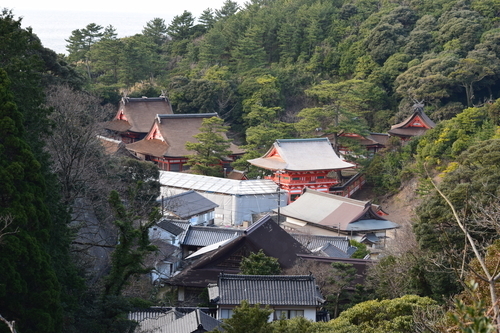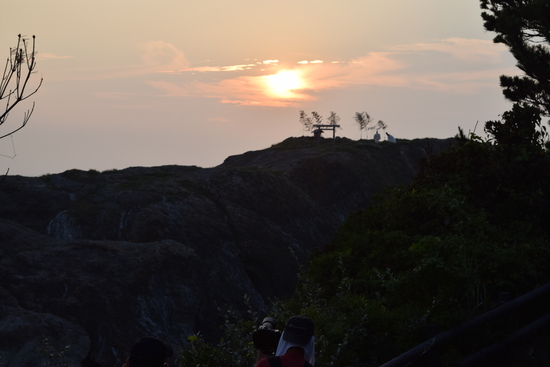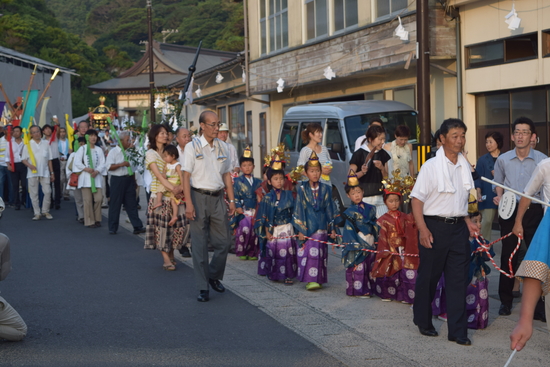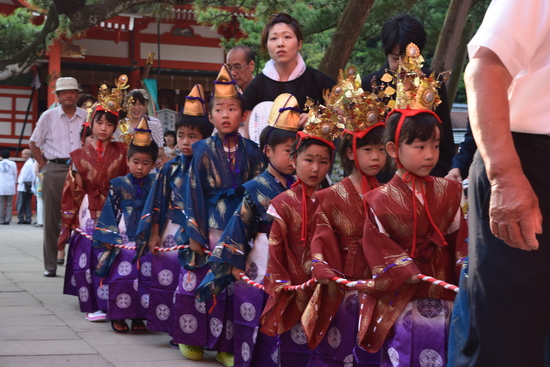Hinomisaki
| Bay Name | Hinomisaki |
|---|---|
| Shrine Name | Hinomisaki-jinja |
| Deity | Kamu Susanoo-no-Mikoto |
| Location | Izumo-shi Taisha-machi Hinomisaki 455 |
Hinomisaki Daijingu
May the abundant prosperity thus far bestowed on our land
Continue for eternity under your light

Just like Kidzuki Taisha, this is also not written about as a ‘bay’. On the subject of Hinomisaki shrine’s location in respect to the nearest bay, the Fudoki states ‘Misaki Hama, 288m wide., inhabited area’. Early prototypes for Hinomisaki-jinja can be seen in the Fudoki as ‘Misaki-no-yashiro’ and ‘Momoenisu’. During his visit in 1863, Kanazaki Zenbei wrote of ‘Misaki Bay with its shrine ‘Misaki Daijingu’.

Entering Hinomisaki-jinja through the ‘Sakura-mon’ leads directly to a large shrine called ‘Hishizumi-no-miya’ which is dedicated to Amaterasu- Omikami. On the right side is a shrine for Kamu Susanoo-no-mikoto called ‘Kami-no-miya’.
It’s said that Ise Shrine protects Japan during the day whereas Hinomisaki –jinja in the West protects it in the evening hence the annual event held on August 7th, the ‘Sunset Festival’.
At 6 p.m. the Shinto Priest and a long line of attendees, set off from Hishizumi-no-miya leading an O-Mikoshi (portable shrine) containing the spirit of the first Hinomisaki head priest, Ame-no-Fukine-no-mikoto. The procession heads towards the opposite shore of ‘Fumishima’ island, the former location (2000 years previously) of Hinomisaki-shrine. Upon reaching ‘Hiwazaki’, the sacred area, the ritual ceremony begins.
The O-Mikoshi is placed on the sacred area facing Fumishima by the shrine parishioners who carried it there. Next, ritual Shinto prayers are said as the O-Mikoshi is offered for worship.
At the same time, a Shinto priest disembarks from a small boat at Fumishima and solemnly carries out a Shinto ritual at Fumishima-jinja.
As for the food and drink offerings, rice, rice cakes, sake, kelp and the food prohibited at Miho-jinja; eggs, are all given. It’s said that prior to the Meiji Period, food was actually prepared in the Gokusho (offering hall) and offered.
It’s not known if there’s a direct connection to the Land Creator kami Susanoo-no-mikoto but the grains of sand from within the grounds of Hinomisaki-jinja are much in demand for Land Breaking ceremonies. From a number of years ago, the sand is thought to have protective properties so is a very popular charm among worshippers.
Hinomisaki is also home to the highest lighthouse in Asia which looks out directly over the Japan Sea. A new hotel was built in the area at the end of last year.
Marine foods such as Hinomisaki seaweed are also popular locally. A souvenir shop near the lighthouse sells grilled turban shells. Enjoy eating the local delicacies while watching the sun set. With Fumishima and its black-tailed gulls to your right, it’s highly recommended to take a stroll along the ancient roads of the bays towards Hinomisaki-jinja.


| Bay Name | Hinomisaki |
|---|---|
| Shrine Name | Hinomisaki-jinja |
| Deity | Kamu Susanoo-no-Mikoto |
| Location | Izumo-shi Taisha-machi Hinomisaki 455 |
Hinomisaki Daijingu
May the abundant prosperity thus far bestowed on our land
Continue for eternity under your light
Just like Kidzuki Taisha, this is also not written about as a ‘bay’. On the subject of Hinomisaki shrine’s location in respect to the nearest bay, the Fudoki states ‘Misaki Hama, 288m wide., inhabited area’. Early prototypes for Hinomisaki-jinja can be seen in the Fudoki as ‘Misaki-no-yashiro’ and ‘Momoenisu’. During his visit in 1863, Kanazaki Zenbei wrote of ‘Misaki Bay with its shrine ‘Misaki Daijingu’.
Entering Hinomisaki-jinja through the ‘Sakura-mon’ leads directly to a large shrine called ‘Hishizumi-no-miya’ which is dedicated to Amaterasu- Omikami. On the right side is a shrine for Kamu Susanoo-no-mikoto called ‘Kami-no-miya’.
It’s said that Ise Shrine protects Japan during the day whereas Hinomisaki –jinja in the West protects it in the evening hence the annual event held on August 7th, the ‘Sunset Festival’.
At 6 p.m. the Shinto Priest and a long line of attendees, set off from Hishizumi-no-miya leading an O-Mikoshi (portable shrine) containing the spirit of the first Hinomisaki head priest, Ame-no-Fukine-no-mikoto. The procession heads towards the opposite shore of ‘Fumishima’ island, the former location (2000 years previously) of Hinomisaki-shrine. Upon reaching ‘Hiwazaki’, the sacred area, the ritual ceremony begins.
The O-Mikoshi is placed on the sacred area facing Fumishima by the shrine parishioners who carried it there. Next, ritual Shinto prayers are said as the O-Mikoshi is offered for worship.
At the same time, a Shinto priest disembarks from a small boat at Fumishima and solemnly carries out a Shinto ritual at Fumishima-jinja.
As for the food and drink offerings, rice, rice cakes, sake, kelp and the food prohibited at Miho-jinja; eggs, are all given. It’s said that prior to the Meiji Period, food was actually prepared in the Gokusho (offering hall) and offered.
It’s not known if there’s a direct connection to the Land Creator kami Susanoo-no-mikoto but the grains of sand from within the grounds of Hinomisaki-jinja are much in demand for Land Breaking ceremonies. From a number of years ago, the sand is thought to have protective properties so is a very popular charm among worshippers.
Hinomisaki is also home to the highest lighthouse in Asia which looks out directly over the Japan Sea. A new hotel was built in the area at the end of last year.
Marine foods such as Hinomisaki seaweed are also popular locally. A souvenir shop near the lighthouse sells grilled turban shells. Enjoy eating the local delicacies while watching the sun set. With Fumishima and its black-tailed gulls to your right, it’s highly recommended to take a stroll along the ancient roads of the bays towards Hinomisaki-jinja.






